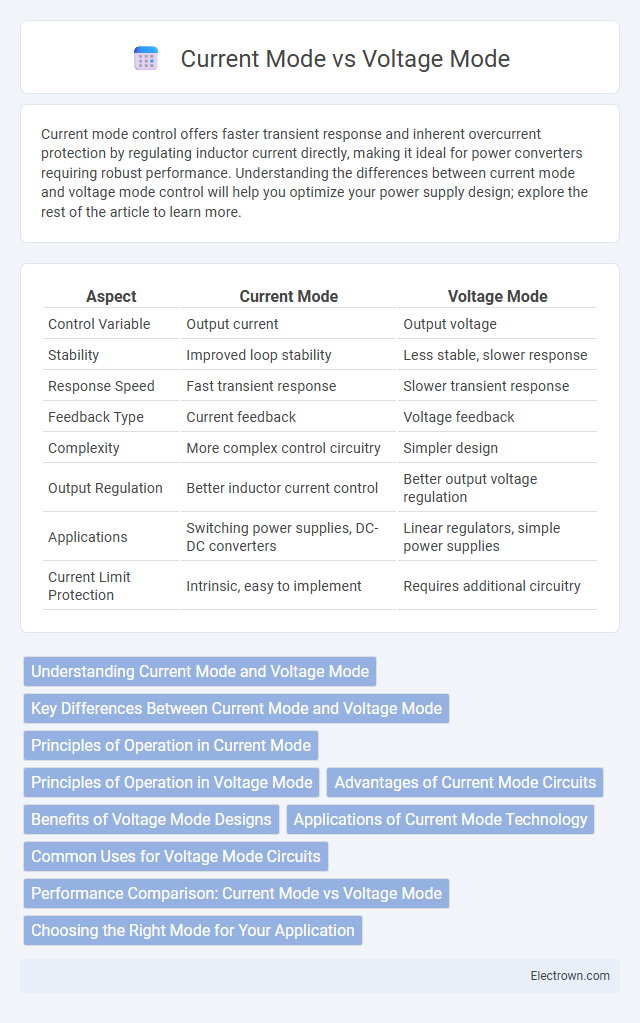Current mode control offers faster transient response and inherent overcurrent protection by regulating inductor current directly, making it ideal for power converters requiring robust performance. Understanding the differences between current mode and voltage mode control will help you optimize your power supply design; explore the rest of the article to learn more.
Table of Comparison
| Aspect | Current Mode | Voltage Mode |
|---|---|---|
| Control Variable | Output current | Output voltage |
| Stability | Improved loop stability | Less stable, slower response |
| Response Speed | Fast transient response | Slower transient response |
| Feedback Type | Current feedback | Voltage feedback |
| Complexity | More complex control circuitry | Simpler design |
| Output Regulation | Better inductor current control | Better output voltage regulation |
| Applications | Switching power supplies, DC-DC converters | Linear regulators, simple power supplies |
| Current Limit Protection | Intrinsic, easy to implement | Requires additional circuitry |
Understanding Current Mode and Voltage Mode
Current Mode control regulates the output by directly controlling the inductor current, providing faster response to load changes and inherent overcurrent protection. Voltage Mode control adjusts the duty cycle based on the output voltage feedback, offering simpler loop compensation and stable operation in a wide range of applications. Your choice between Current Mode and Voltage Mode impacts the power supply's transient response, stability, and complexity.
Key Differences Between Current Mode and Voltage Mode
Current mode control regulates the output by monitoring the inductor current, offering faster response and improved stability in switching power supplies. Voltage mode control relies on feedback from the output voltage, providing simpler design but slower reaction to load changes and potential instability at high frequencies. Your choice between current mode and voltage mode affects the power supply's dynamic performance, noise immunity, and overall control complexity.
Principles of Operation in Current Mode
Current mode control regulates the output by directly monitoring and controlling the inductor current, enabling faster response to load changes and improving system stability. It uses the inductor current as a feedback signal to modulate the duty cycle of the switching device, achieving precise peak current regulation. This method reduces the control loop complexity by converting the power stage into a current source, simplifying compensation and enhancing transient response in power converters.
Principles of Operation in Voltage Mode
Voltage Mode control operates by regulating the output voltage through direct feedback from the output to the error amplifier, which adjusts the pulse-width modulator accordingly. The error amplifier compares the output voltage to a reference voltage, generating an error signal to maintain a stable output voltage under varying load conditions. This mode ensures simplicity and fast response in power supplies by controlling the duty cycle of the switching device based on voltage deviations.
Advantages of Current Mode Circuits
Current mode circuits offer improved stability and faster response times compared to voltage mode circuits due to their inherent ability to sense and control inductor current directly. They provide enhanced line and load regulation, minimizing output voltage ripple and improving transient performance. Your power supply design benefits from simpler compensation requirements and better immunity to noise in current mode operation.
Benefits of Voltage Mode Designs
Voltage mode designs offer precise control over output voltage, enabling stable and accurate regulation across varying loads and input conditions. They typically feature simpler feedback loops and faster transient response, which improves overall circuit stability and performance. These designs are widely preferred in applications requiring high efficiency and low noise, such as power supplies and analog signal processing.
Applications of Current Mode Technology
Current mode technology is widely used in power supply circuits, such as DC-DC converters and switching regulators, where precise control of the output current ensures improved stability and transient response. It is particularly favored in applications requiring fast load regulation and inherent overcurrent protection, including battery chargers, LED drivers, and motor control systems. The technology's ability to maintain consistent current flow regardless of voltage variations makes it ideal for high-performance communications and automotive electronics.
Common Uses for Voltage Mode Circuits
Voltage mode circuits are commonly used in applications requiring precise voltage regulation, such as power supplies, audio amplifiers, and signal processing systems. These circuits provide stable output voltage and are preferred in environments with low noise and ripple sensitivity. Their simplicity and ease of control make them ideal for linear regulators and low-frequency switching power converters.
Performance Comparison: Current Mode vs Voltage Mode
Current mode control offers faster transient response and improved loop stability compared to voltage mode control, making it ideal for applications requiring high dynamic performance. Voltage mode control typically provides simpler loop compensation and better noise immunity but may exhibit slower transient response under load changes. The choice between current mode and voltage mode control depends on the specific application demands for speed, stability, and noise performance.
Choosing the Right Mode for Your Application
Current mode control offers superior response to input voltage variations and inherent overcurrent protection, making it ideal for applications with fluctuating loads or requiring fast transient response. Voltage mode control provides simplicity and ease of implementation, better suited for systems with stable input voltage and less demanding dynamic performance. Evaluating your application's load characteristics, response speed, and protection needs will guide you to select the control mode that ensures optimal performance and reliability.
Current Mode vs Voltage Mode Infographic

 electrown.com
electrown.com